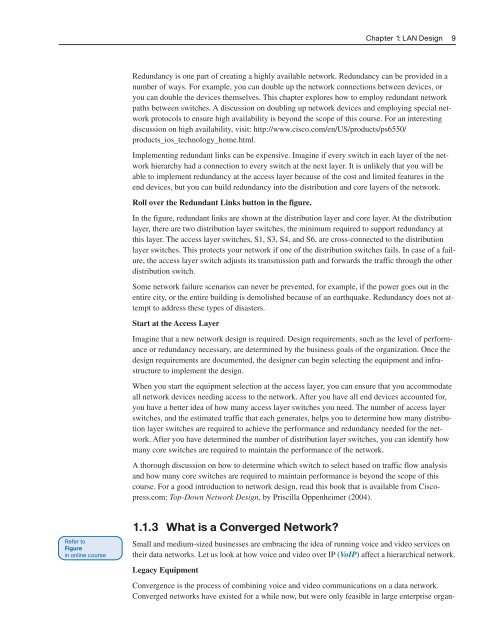CCNA Exploration LAN Switching and Wireless
CCNA Exploration LAN Switching and Wireless
CCNA Exploration LAN Switching and Wireless
Create successful ePaper yourself
Turn your PDF publications into a flip-book with our unique Google optimized e-Paper software.
Chapter 1: <strong>LAN</strong> Design 9<br />
Redundancy is one part of creating a highly available network. Redundancy can be provided in a<br />
number of ways. For example, you can double up the network connections between devices, or<br />
you can double the devices themselves. This chapter explores how to employ redundant network<br />
paths between switches. A discussion on doubling up network devices <strong>and</strong> employing special network<br />
protocols to ensure high availability is beyond the scope of this course. For an interesting<br />
discussion on high availability, visit: http://www.cisco.com/en/US/products/ps6550/<br />
products_ios_technology_home.html.<br />
Implementing redundant links can be expensive. Imagine if every switch in each layer of the network<br />
hierarchy had a connection to every switch at the next layer. It is unlikely that you will be<br />
able to implement redundancy at the access layer because of the cost <strong>and</strong> limited features in the<br />
end devices, but you can build redundancy into the distribution <strong>and</strong> core layers of the network.<br />
Roll over the Redundant Links button in the figure.<br />
In the figure, redundant links are shown at the distribution layer <strong>and</strong> core layer. At the distribution<br />
layer, there are two distribution layer switches, the minimum required to support redundancy at<br />
this layer. The access layer switches, S1, S3, S4, <strong>and</strong> S6, are cross-connected to the distribution<br />
layer switches. This protects your network if one of the distribution switches fails. In case of a failure,<br />
the access layer switch adjusts its transmission path <strong>and</strong> forwards the traffic through the other<br />
distribution switch.<br />
Some network failure scenarios can never be prevented, for example, if the power goes out in the<br />
entire city, or the entire building is demolished because of an earthquake. Redundancy does not attempt<br />
to address these types of disasters.<br />
Start at the Access Layer<br />
Imagine that a new network design is required. Design requirements, such as the level of performance<br />
or redundancy necessary, are determined by the business goals of the organization. Once the<br />
design requirements are documented, the designer can begin selecting the equipment <strong>and</strong> infrastructure<br />
to implement the design.<br />
When you start the equipment selection at the access layer, you can ensure that you accommodate<br />
all network devices needing access to the network. After you have all end devices accounted for,<br />
you have a better idea of how many access layer switches you need. The number of access layer<br />
switches, <strong>and</strong> the estimated traffic that each generates, helps you to determine how many distribution<br />
layer switches are required to achieve the performance <strong>and</strong> redundancy needed for the network.<br />
After you have determined the number of distribution layer switches, you can identify how<br />
many core switches are required to maintain the performance of the network.<br />
A thorough discussion on how to determine which switch to select based on traffic flow analysis<br />
<strong>and</strong> how many core switches are required to maintain performance is beyond the scope of this<br />
course. For a good introduction to network design, read this book that is available from Ciscopress.com:<br />
Top-Down Network Design, by Priscilla Oppenheimer (2004).<br />
1.1.3 What is a Converged Network?<br />
Small <strong>and</strong> medium-sized businesses are embracing the idea of running voice <strong>and</strong> video services on<br />
their data networks. Let us look at how voice <strong>and</strong> video over IP (VoIP) affect a hierarchical network.<br />
Legacy Equipment<br />
Convergence is the process of combining voice <strong>and</strong> video communications on a data network.<br />
Converged networks have existed for a while now, but were only feasible in large enterprise organ-

















